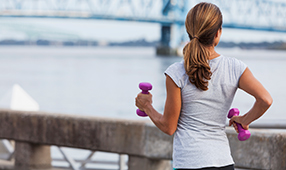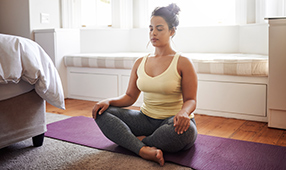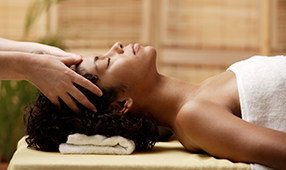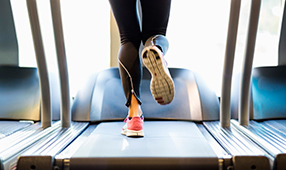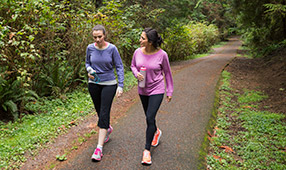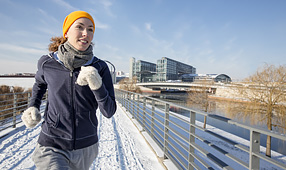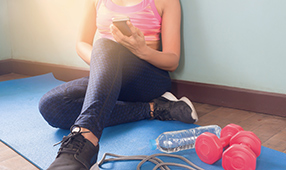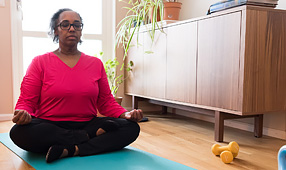It’s not uncommon to feel pain, strain and muscle weakness when you’re on your feet all day. Your back aches, your dogs are barking and all you want to do is sit down. These symptoms are telling you that your body is weak and off balance—but the good news is when you strengthen weak areas, you can say goodbye to foot pain.
To get started, try these four strategies to set yourself up for success.
1. Choose shoes that are comfortable and supportive
High heels, flip-flops, strappy sandals and even unsupportive flats (think ballet slippers) wreak havoc on the body. When you wear shoes that force you to transfer weight toward the toe and away from the heel (like pumps and high heels), your gait dramatically shifts. Similarly, if you wear shoes with only of a thin strap of plastic, you alter the way you walk, shortening your stride and scrunching your toes, which increases the angle of the ankle.
The best shoes for teachers who stand all day are the ones that provide arch support, help cushion your joints, keep your body in alignment, are breathable and leave your feet feeling good at the end of a long school day.
“Your best bet is to choose comfortable footwear that supports your feet,” says Karen Jacobs, Ed.D., OTR/L, program director of Distance Education Post-Professional Occupational Therapy Programs and clinical professor at Boston University College of Health and Rehabilitation Sciences.
For added comfort, Jacob recommends wearing insoles to provide extra cushioning, especially if you have to wear dressier work shoes. If possible, look for rubber sole options, which can provide a barrier between your joints and hard classroom floors. Flat shoes, such as ballet flats or flat sandals, may appear to be more comfortable than heels, but the lack of arch support can end up causing discomfort.
Cheap shoes can seem like a real steal, but consider investing in quality comfort footwear. That can be a wise investment because well-made shoes can help reduce or prevent health issues. One example is plantar fasciitis, which is heel pain that can be further aggravated by standing for long periods of time in shoes that don’t provide enough cushioning or support.
Teachers are always on the lookout for comfy shoes and sneakers that don’t break the bank. You can search for deals and cash-back offers on comfortable teacher shoes through NEA Discount Marketplace. Click “All Stores” and search under “Clothing,” “Shoes & Handbags” and “Sports & Outdoors” to browse retailers.
Offers change, so check back regularly. Through NEA Discount Marketplace, you can typically purchase shoes by popular comfort shoe retailers such as Rothy’s, Lifestride, Merrell, Clarks, Dansko, Aerosoles, New Balance, Adidas, Easy Spirit, Hush Puppies, Rockport, Sorel, Taos, Toms, Vionic and more—either directly from the manufacturer or through third-party retailers such as Zappos, Macys, Famous Footwear, Shoemall.com and many more.
See more about how the NEA Discount Marketplace shopping benefit works.
2. Stand tall to improve your alignment
Watch most educators stand and you’ll see why so many have pain in the neck, back and shoulders. Poor posture runs rampant, particularly an imbalance known as “forward head” (also called “text neck,” “scholar’s neck,” or “reading neck”) in which your head extends forward beyond your shoulders instead of resting straight atop your spine where it should be.
When your head tilts forward like that, it shifts your body’s center of mass forward. That increases pressure on the arch of the foot and the muscles that support it, causing them to work harder and eventually strain. You can help to correct this forward-tilting position by keeping your ears over your shoulders and your shoulders over your hips.
“If you can envision a little string that travels through your midline, that’s good posture,” says Jacobs.
Another tip: During your off time, flex your feet toward your shins to strengthen the muscles in front of the lower leg. That helps support the arch of the foot.
Get more tips about how to cope with common educator health issues, such as eye strain, vocal disorders and stress.
3. Make time to warm up your muscles
“Look at yourself as an athlete,” suggests Jacobs. “Before you start your work day, do some stretching and at the end of the day, cool down with more stretching.”
You can walk to work to get your muscles warmed up or consider incorporating activities that require movement into the classroom. Add a stretching or moving break every 20-30 minutes, for example.
“That will really help reduce fatigue for both you and your students,” she says, “and it instills good habits at the same time.”
During your off hours, build exercise into your daily routine, especially stretching activities like yoga.
4. Build strength from your head to your toes
The human head weighs 10-12 pounds—about the same as a bowling ball! When your head leans forward 15 degrees, the tilt makes the weight of your head feel closer to 30 pounds. The further forward your head leans, the heavier it feels. Imagine holding a bowling ball in front of you all day and you’ll get a sense of what happens with poor posture.
To support this weight, you need to build strength in your abdominals, glutes, hamstrings and hip flexors. Building muscle increases your functional capacity.
“Since most people stand slightly hunched forward, their skeletons are not in a position to support them so their muscles have to kick in,” says Mitchell Yass, DPT (Doctor of Physical Therapy), author of The Yass Method for Pain-Free Movement, The Pain Cure, and Overpower Pain. “Ultimately you have to strengthen the muscles that help you stand upright.” The result: less strain and less pain.
If you’re experiencing pain in your knees, back, hips and more from being on your feet all day, Yass recommends performing the following two exercises, twice a week for 15 minutes to strengthen your target muscles—and thus minimize the toll standing takes on the body. (Consult with your physician first.)
- Deadlifts, to work your glutes and hamstrings: Stand up and make a fist like you’re holding a dumbbell. Your palms should be facing your thighs. Unlock your knees, keep your back straight, and slide your hands down your thighs until they reach half-way down your shins (make sure to keep the weight in your heels so you’re not leaning forward). When you feel a tightness in the back of your thigh, you’ve exhausted full range of motion. Return to standing and repeat. As you get stronger, do the exercise with dumbbells, gradually increasing the weight as you improve. Do three sets of 10 repetitions, resting for two minutes between sets.
- Side-lying hip abduction, to strengthen your hips: Lie down on your side and bend the leg that you’re lying on. Straighten your top leg so it lines up with your torso. Then raise your top leg until it’s parallel to the ground or hip height (never go above hip height). As you get stronger, add a cuff weight around your ankles. Try three sets of 10 repetitions, resting for two minutes between sets.
Schools are mandated to have occupational practitioners available to teachers. “They’re in every school throughout the United States,” says Jacobs. “So you don’t have to do this alone. Occupational therapy practitioners will come to your teachers’ meetings and give you strategies for things you can do both inside and outside the classroom.” So what are you waiting for? It’s time to get through your day without pain!


